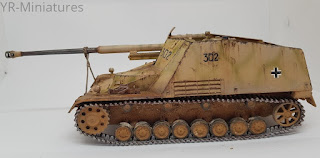Nashorn (German "rhinoceros"), initially known as Hornisse (German "hornet"), was a German tank destroyer of World War II. It was developed as an interim solution in 1942 by equipping a light turretless chassis with the Pak 43 heavy anti-tank gun. Though only lightly armoured and displaying a high profile, it could frontally penetrate any Allied tank at long range, and its relatively low cost and superior mobility to heavier vehicles ensured it remained in production until the war's end.
The Hornisse/Nashorn was issued to the heavy anti-tank battalions (Schwere Panzerjäger-Abteilungen), with which six would eventually be equipped: Schwere Panzerjäger Abteilung 560, 655, 525, 93, 519 and 88. Each battalion was equipped with 45 Nashorns. Most of the Nashorns in these units fought either on the Eastern Front or in Italy, few having been sent to Western Europe.
The Nashorn's gun was a variant of the Pak 43, one of the most effective anti-tank guns deployed during the war and closely related to guns used later for the Ferdinand/Elefant, Tiger II and Jagdpanther. Its tungsten carbide–cored round, the Pzgr. 40/43, was capable of penetrating 190 mm of rolled steel armour at a 30° angle of impact at a distance of 1,000 m. The gun's performance enabled Nashorns to penetrate the front armour plating of any Allied combat vehicle and to engage enemy units while staying out of range themselves, thanks to its combination of excellent gunsights and optics and the highly-accurate gun.
The Hornisse/Nashorn made its debut during the Battle of Kursk in 1943, where it performed considerably well. The ability to engage the enemy at long distances negated the disadvantages of its light armour, lack of a roof and a large profile, and revealed that the weapon was suited to the open and flat landscape (vast steppes) of much of the Soviet Union. In Italy, however, the generally hilly terrain was not as favorable to the harnessing of the Nashorn's full ability at accurate long-range fire against enemy forces as in Russia.
On 6 March 1945, a US Army M26 Pershing heavy tank was knocked out by a Nashorn in the town of Niehl near Cologne, at a close range of under 300 yd (270 m).




















No comments:
Post a Comment